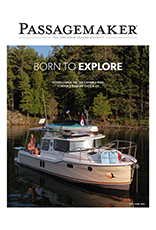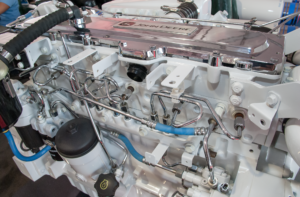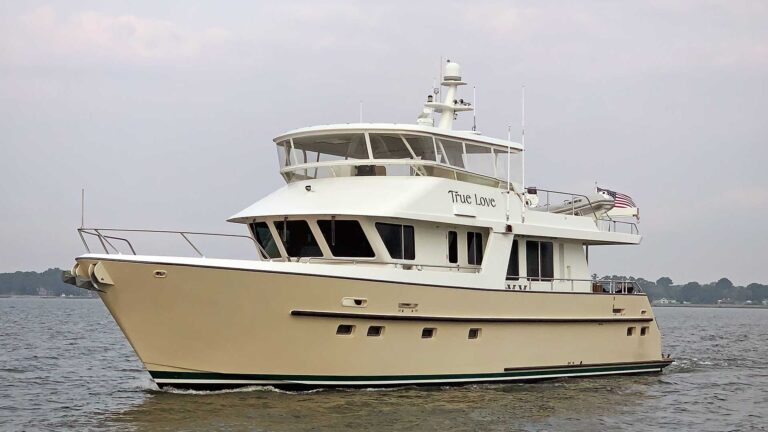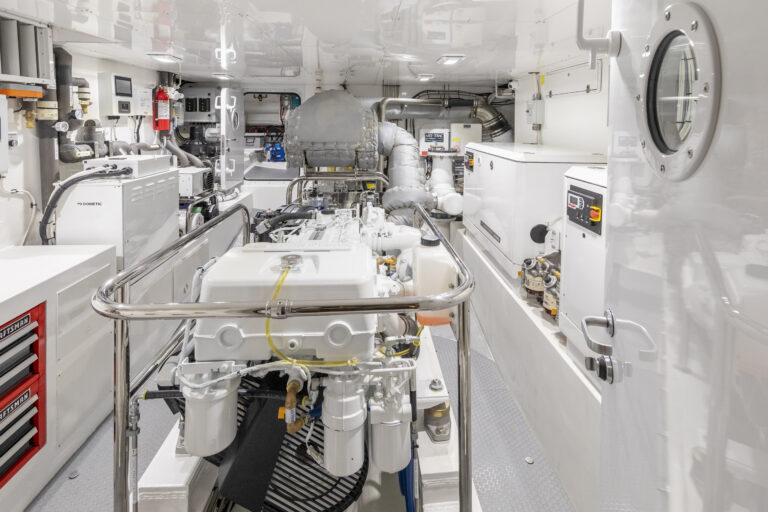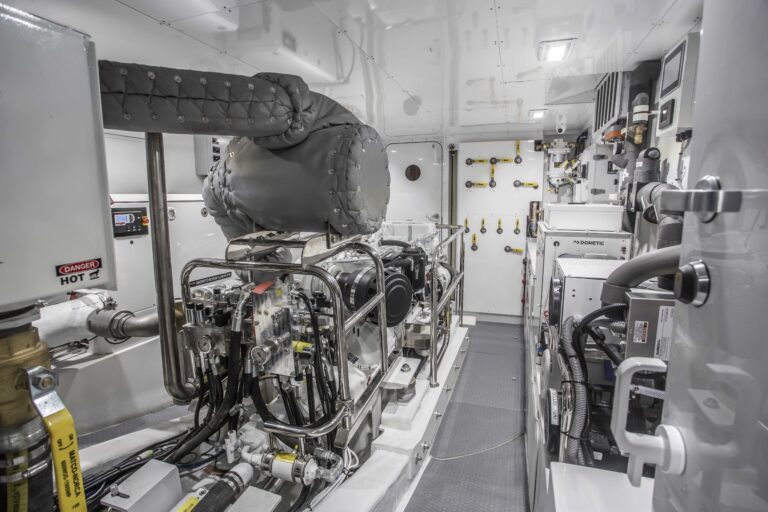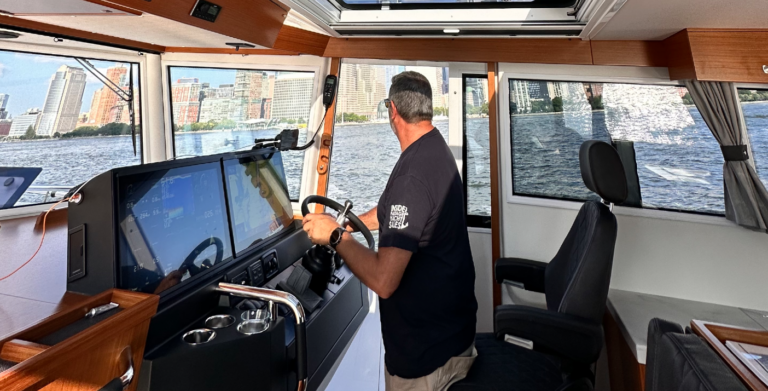
With every sweep of the radar beam, a brightly colored image of the shoreline appears along the edge of the dark screen. It is a reassuring presence, a reminder that only a slight change in heading will take you to the safety of a nearby inlet.
A lot of cruisers spend the whole of their boating lives watching that image at the helm, but increasingly, more and more trawler owners are willing to forgo the comfort and instead consider a long-distance itinerary. I don’t mean the daunting task of crossing an ocean, but rather exploring offshore destinations—the type of long-distance cruising my wife, Dori, and I had in mind when we built our 54-foot Ocean Alexander Liberdade. Now, after years aboard, I’m able to share our lessons learned. They go far beyond the basics that most new long-distance cruisers will find in books and classes.
The first thing to understand is that the seriousness and consequences of long-distance ocean passages increase significantly along with time and distance from the shelter of a safe harbor. As we ventured farther from shore, we realized that we were crossing boundary lines where the degree of self-sufficiency grew exponentially greater.
The first line crossed is when you are farther from a safe harbor than can be reached within daylight’s travel. This distance, of course, will vary with your boat’s speed; however, the implications are the same. Attempting a return to a challenging inlet or difficult shoreline has its risks during daylight. Doing it in darkness may not be possible.
The next line crossed is when you travel beyond the range of a recreational towing company’s assistance. While recreational towing services may not have a specific distance beyond which they will offer towing services, they do have limits. How far offshore they will go to get you is limited by sea conditions, the fuel capacity of their boats, and their ability to communicate with you. A representative of Sea Tow, a leading recreational towing franchise, says that in some cases, it defers to the U.S. Coast Guard.

I encountered just such a situation while acting as the dedicated person ashore for a friend who was cruising from Man-O-War Cay in the Bahamas to Beaufort, North Carolina. The vessel lost power 120 nautical miles from Cape Canaveral, Florida. The captain contacted me by satellite communications and asked me to call the towing company. Unfortunately, the vessel was too far from shore to be towed in. I then contacted the Coast Guard, which offered to stand by and respond if the captain activated his emergency beacon—but in that instance, everyone aboard would be required to abandon the vessel upon rescue. This was not an option my friend wanted to consider. Eventually, I was able to get a compassionate Coast Guard station officer to dispatch a cutter to tow the boat within the towing company’s range.
The last line crossed is when you really know you are on your own. It is when you are beyond the range of a rescue helicopter. The maximum range of a Coast Guard Jayhawk helicopter is 700 nautical miles. Allowing for the flight out and back, this capacity provides a rescue range of approximately 300 nautical miles, given the fuel needed for hover and rescue time. Once you are beyond that reach, self-sufficiency takes on a whole new meaning.
Planning a Long-Distance Cruise
While the idea of being miles at sea in a small boat may sound risky, preparation and training can mitigate risk. Take the time to learn all of the systems on your boat and to know what you would do if any one of them failed. Make sure every member of your crew understands the backup plans. Overall, try to think like NASA astronaut and oceanographer Megan McArthur, who says, “It’s important to know as a team you can work together to get through any situation. It’s not because you think problems will happen, but you prove to yourself that you have the ability to work through them together if they do.”

Next, think about redundancy. When a trip to the ship’s store isn’t an option, having the right spare parts and backup systems on board can save the day. Identify every single point of failure that could jeopardize your success or safety, and have a backup plan. All helm navigation systems should be duplicated in GPS, navigation software, radar and depthsounders. At least one battery-powered, handheld GPS device is also a good idea, in case a lightning strike takes out the vessel’s electrical system. Lightning can also disable the electronic control unit required to operate a modern diesel engine. These units are typically plug-and-play modules. One programmed to your engine specifications would be a handy spare to have on board.
A frequently overlooked component when thinking about redundancy is the autopilot. Hand-steering a boat in the ocean for even a moderate distance is a physically and mentally tiring experience. Doing it for days would border on dangerous.
And remember to pay attention to your ship’s magnetic compass. Too often ignored today with modern electronics, the ship’s compass could be your most valuable tool in a catastrophic system failure. Make sure yours is accurate on all points.
Spare parts and tools also require attention. All major component manufacturers will have either a preassembled spares kit or the most commonly ordered spare parts. Consult with service technicians about their experience repairing your particular boat’s systems. In addition to carrying a complete set of mechanical and electrical tools, you want to have any special tools required to remove impellers, retaining clips or specialty fasteners.

Also think about crew. Whether you take on a long-distance itinerary as a couple or invite others to join you, ocean passages are team events. Each team member needs to accept a set of responsibilities. Dependable, knowledgeable crew is important for a safe passage—and that knowledge should be overlapping. There can’t just be one person who understands the workings in the engine room, or only one cook. If one member becomes ill or disabled, others have to step in with knowledge of all aspects of running the boat.
Establish a routine and watch schedule. This is one of the most important aspects of multiple-day long-distance cruising. Watch schedules for a cruising couple are typically three- or four-hour intervals. The watches may also vary between day and night, or in severe weather. What is most important is that a routine is set and followed. This is difficult to achieve if both crewmembers are inclined to stay awake during the day. It is not helpful to have two tired people going into the evening hours.
A four-hour watch shift follows the science of sleep, which is regulated in natural circadian rhythms. While sleeping, our bodies experience a series of cycles, each lasting approximately 90 minutes, with deep sleep and REM sleep being the time when most of the body’s restorative work is done. The four-hour shift allows you to rest through two of those cycles, with enough time to fall asleep and slowly wake yourself up for your watch. While we all are subject to the laws of nature, everyone’s sleep requirements are different. Find what works best for your crew. Dori and I prefer a loose three-hour schedule during the day, and we try to allow ourselves four hours at night.
Our friends Laurie and Alec Thyrre, aboard their Nordhavn 64 Gratitude, go with a three-hour schedule. They also consider arrival and departure times on shorter passages. “While arriving at a destination early in the morning has some advantages, it is a disaster in terms of sleep,” Alec says. “Taking into account the sleep schedule, the only way to get even close to a decent amount of sleep is if you arrive after 12 o’clock noon. Sometimes, delaying departure on the first day to ensure a late-morning or early-afternoon arrival on the final day makes more sense.” (Assuming there are no other priorities, such as the need to arrive for a specific tide or current.)
An important, yet often-overlooked aspect of watch schedules is the handoff between crew. Every change at the helm should come with a thorough briefing. Give the person coming onto the watch all the details of what you saw during your shift. Let him or her know if you changed or adjusted anything at the helm. Make clear anything that requires immediate attention. Where did you last see any other vessels, and where are they now? What changes have you observed in wind or sea conditions? Share any radio conversations you had with other vessels. When in critical habitat areas, discuss any marine-life sightings. Keep the discussion simple but informative.

Nourishment is just as important as sleep for a safe long-distance passage. Good-quality food also affects our emotional and mental states. A protein cake and water may sustain you, but they would make for a pretty cranky crew. Calm seas allow for leisurely food preparation and eating. When conditions get a little lumpy, food needs to be simple to prepare and consume. Extra freezer space on a boat is paramount. Dori and I prepare meals ahead of the trip and freeze them in easy-to-heat portions. Lasagna, baked ziti and chicken casseroles freeze and reheat well. Dori and I also find that freezing meals in foil and then reheating them in the oven preserves the quality better than reheating in the microwave.
Getting Underway
It is equally important to feed the boat. One of the most frequent causes of a disabled power vessel is failing to feed the engine enough good, clean fuel. The movement of a vessel in the open ocean can disturb biological growth, water and debris on the bottom of a fuel tank. This material can quickly block filters, preventing an adequate amount of fuel from getting to the engine. Make sure you begin your passage with clean fuel in clean tanks. As an extra measure of safety, carry a sufficient supply of fuel filters—and know what sufficient means. On one passage that a friend made aboard a small trawler from Key West, Florida, to Isla Mujeres, Mexico, the crew made 15 fuel filter changes during the 350-mile trip to keep the engine running.
Fuel management also means conservative calculations. Fuel use in the open ocean may be greater than what you’ve experienced in other conditions. Climbing ocean swells can significantly increase fuel use. Additional fuel will also be needed to run the generator. Several days underway will likely require more generator use than may have been necessary on shorter coastal passages.
Also, watch out for the frequently occurring problem of mismanagement of fuel in multiple tanks. Many boats have a fuel-transfer system required to keep a day tank supplied. Be certain that everyone on board knows how to operate it, and that all of the components are in good working order.
Route planning and weather forecasting also need your attention. An accurate forecast is only good for about eight hours. When coastal cruising from inlet to inlet, it’s easy to stay within the limit of a predictable forecast. With long-distance cruising, you may be at sea longer than a forecast can guarantee conditions. On multiday trips consisting of hundreds of miles, you need to take localized weather patterns into consideration for route-planning. Weather routers who specialize in guiding long-distance cruisers will provide a waypoint to steer to each day, to keep the boat in the best conditions.
Knowledgeable cruisers can do the same thing with different forecast models, but make sure you compare multiple models when planning a route. Four to five days out, different models can show considerable variations. As the time gets shorter, the models tend to come into alignment. Only then can you have confidence that the forecasts are likely to be accurate. Whether by satellite or single-sideband radio, make sure you have the ability to obtain updated forecasts once you’re beyond mobile phone connectivity.
And, know that any boat you would consider taking on a long-distance trip will be required to carry signaling devices. Not all signaling devices are created equal. The Coast Guard has minimum standards acceptable for most inland and coastal cruising, however, in an open ocean where rescuers could be searching a large area, higher-performance signaling devices are recommended.
The Safety of Life at Sea international convention has established minimum requirements for signaling devices. While the candle power (or brightness) of a commonly used Coast Guard-approved parachute flare is 10,000 CP with a burn time of 20 seconds, the candle power of a typical SOLAS-grade parachute flare is 30,000 CP with a burn time of 40 seconds. Upgrade all of your safety equipment to SOLAS level.
In fact, the ability to communicate is vital throughout your voyage. Satellite communicators such as inReach Spot and Iridium GO! are easy to use and can provide weather forecasts. Also think about float plans, which are a basic part of boating safety—and even more important in long-distance cruising. In your float plan, designate a responsible person to follow your progress, knowing your route, speed and when you are expected to arrive at your destination. This is not only important for your safety but also offers a reassuring connection for the crew.
Long-distance cruising is within the capabilities of many cruisers. With the right preparations, you, too, can join this intrepid group who choose to turn their sterns to the coast and head out for distant destinations.
Top 10 Spares
Stock up on these commonly needed replacement parts before heading offshore
• Fuel filters
• Belts
• Seawater coolant pump impellers
• Complete pump assemblies
• Hydraulic hoses, fittings and plugs
• Hydraulic fluid
• Engine alternator
• Electrical splice connectors and ring terminals
• Electrical fuses and marine-grade wire
• Spare head parts
Offshore Cruising Safety Essentials
Satellite Communication Devices

Satellite-connected devices help you stay in touch globally. You can send and receive messages, navigate your route, track and share your journey and, if necessary, trigger an SOS to get help from a 24/7 global emergency response coordination center via the Iridium satellite network.
USCG-Approved Parachute Flares & EPIRB

Impossible to miss at its peak altitude of 1,000 feet, the SOLAS red parachute flare achieves an intense brilliance of 30,000 candle power and a burn time of 40 seconds to alert others of a distress situation, day or night.
An emergency position indicating radio beacon provides worldwide coverage, position location accuracy, a reliable transmitted signal, and an encoded message that identifies the distressed vessel, aiding in a faster response time.
